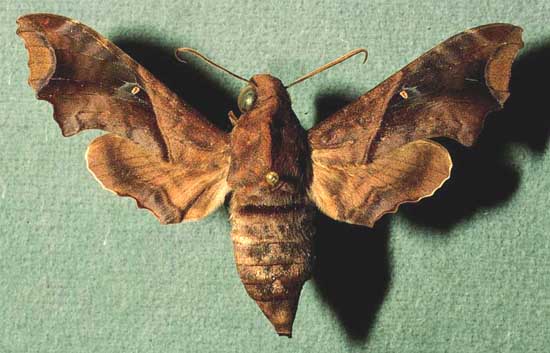
Enyo ocypete female courtesy of Dan Janzen.
This site has been created by Bill Oehlke.
Comments, suggestions and/or additional information are welcomed by Bill.
TAXONOMY:
Family: Sphingidae, Latreille, 1802 |
|
|
Updated as per
AN ANNOTATED CHECKLIST OF THE SPHINGIDAE OF BOLIVIA, October 2007 Updated as per http://www.pybio.org/MACROGLOSSINAE.htm (Paraguay), October 2007 Updated as per personal communication with Ezequiel Osvaldo Núñez Bustos, Argentina, March 2008 Updated as per personal communication with Johan van't Bosch (Mato Grosso, Brazil, October 4), March 2008 Updated as per personal communication with Vladimir Izersky (February, April, 662m, Coviriali, Junin, Peru) December 2008 Updated as per personal communication with Jose Monzon (Guatemala); May 2009 Updated as per personal communication with Ezequiel Bustos (Aguas Blancas, Salta, Argentina, 405m); December 2009 Updated as per Sphingidae (Lepidoptera) de Venezuela, Compilado por: María Esperanza Chacín; December 2009 Updated as per personal communication with Larry Valentine (Itanhandu, Minas Gerais, Brazil, December 2009); January 1, 2010 Updated as per personal communication with Gregory Nielsen (Villavicencio, Meta, Colombia, January 19, 2011, 500m); February 6, 2011 Updated as per French Guiana Systematics; April 12, 2011 Updated as per personal communication with Shirley Sekarajasingham (Loreto, Peru, September 24, 2008); October 5, 2012 Updated as per "A Hawk Moths fauna of southern Maranhão state, Brazil, ... "; NEVA: Jahrgang 34 Heft 3 November 2013; via Jean Haxaire; April 5, 2014 Updated as per personal communication with Sergio D. Ríos Díaz in CATÁLOGO DE LOS SPHINGIDAE (INSECTA: LEPIDOPTERA) DEPOSITADOS EN EL MUSEO NACIONAL DE HISTORIA NATURAL DEL PARAGUAY; sent to me in July 2014 by Sergio D. Ríos Díaz. Updated as per personal communication with Ezequiel Bustos (Shilap revta. lepid. 43 (172) diciembre, 2015, 615-631 eISSN 2340-4078 ISSN 0300-5267), January 4, 2016 Updated as per personal communication with Cesar Ivan Caballero de la Cruz (Motupe, Lambayeque, Peru, March 25, 2019), March 29, 2019 Updated as per personal communication with Altervir Balista (D'agua, Goias, Brazil, April 21, 2019), April 22, 2019 Updated as per personal communication with Kennedy Road (Aruana, Goias, Brazil, May 1, 2020), May 1, 2020 |

This site has been created by Bill Oehlke.
Comments, suggestions and/or additional information are welcomed by Bill.
TAXONOMY:
Family: Sphingidae, Latreille, 1802 |
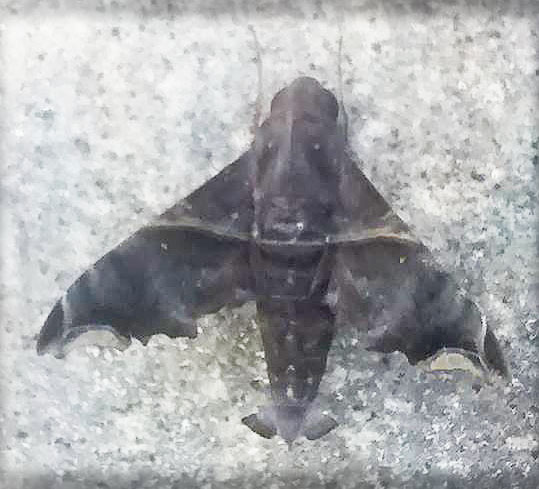
Enyo ocypete, Olhos D'agua, Goias, Brazil,
April 21, 2019, courtesy of Altervir Balista, id by Bill Oehlke.
Enyo ocypete is very similar to E. lugubris, but ocypete seems to have a lighter, more deeply scalloped area just below the forewing apex. The cell mark is also smaller in ocypete.
Each antenna has a prominent apical brush of scales.
On the male hindwing upperside there is a diagnostic pale yellowish-white anal patch.
Females are similar to Enyo lugubris lugubris, but are easily distinguished by the broad brown belt across the base of the abdomen dorsally
(this belt is either very narrow or absent in Enyo lugubris lugubris).
The forewing upperside has a dark area not sharply defined, prolonged along the antemedian line to posterior margin. The discal spot is small.
CATE
Sphinx camertus Cramer, 1780, Surinam, is same as Enyo ocypete. Enyo ocypete, September 6, 2002 - 9:35 PM, courtesy of Steve Graser. | 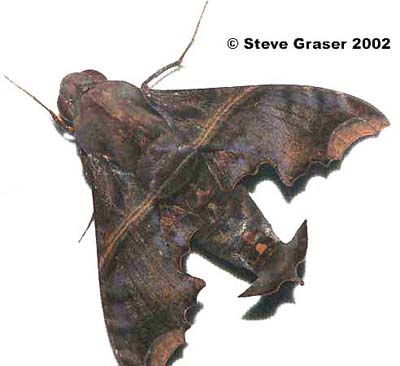 |
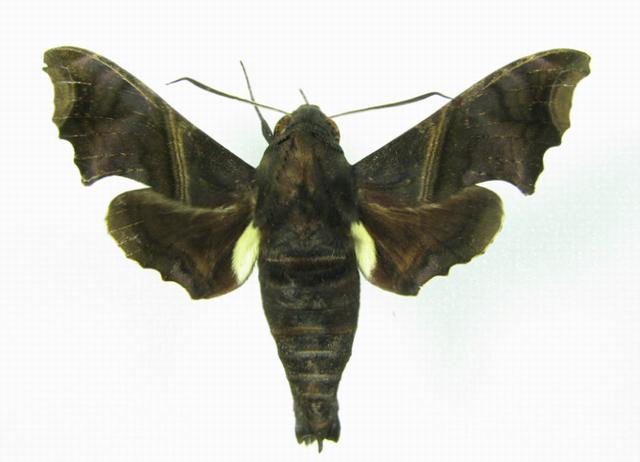
Enyo ocypete male, Villavicencio, Meta, Colombia,
January 19, 2011, 500m, courtesy of Gregory Nielsen.
Vladimir Izersky confirms flights in February and April in Junin, Peru. Cesar Ivan Caballero de la Cruz reports a March flight in Motupe, Lambayeque, Peru.
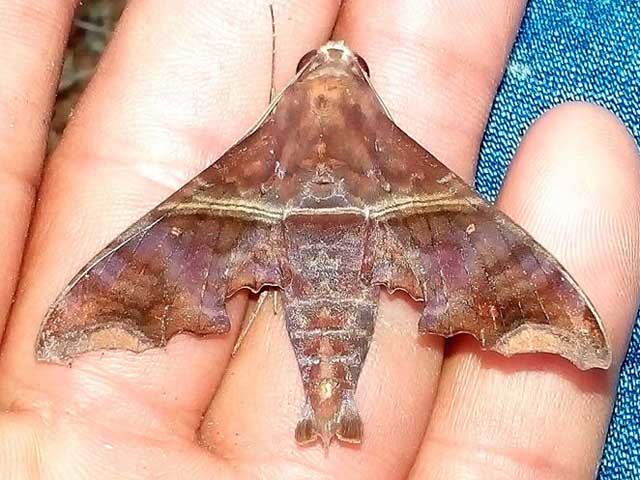
Enyo ocypete, Motupe, Lambayeque, Peru, March 25, 2019,
courtesy of Cesar Ivan Caballero de la Cruz, id by Bill Oehlke.
Visit Enyo ocypete male and female, live and spread, Coviriali, Junin, Peru, 662m, courtesy of Vladimir Izersky.
Visit Enyo ocypete male (recto and verso), Itanhandu, southern Minas Gerais, Brazil, December, 2009; July 25, 2012, courtesy of Larry Valentine.
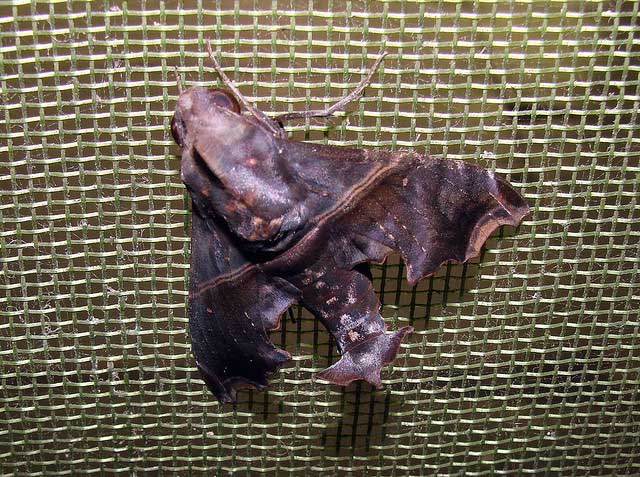
Enyo ocypete male, Loreto, Peru,
September 24, 2008, courtesy of Shirley Sekarajasingham, id by Bill Oehlke.
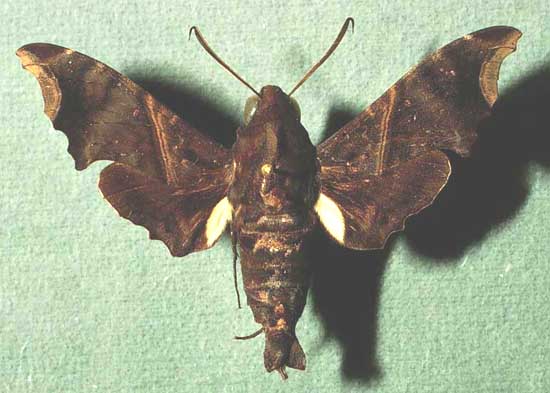
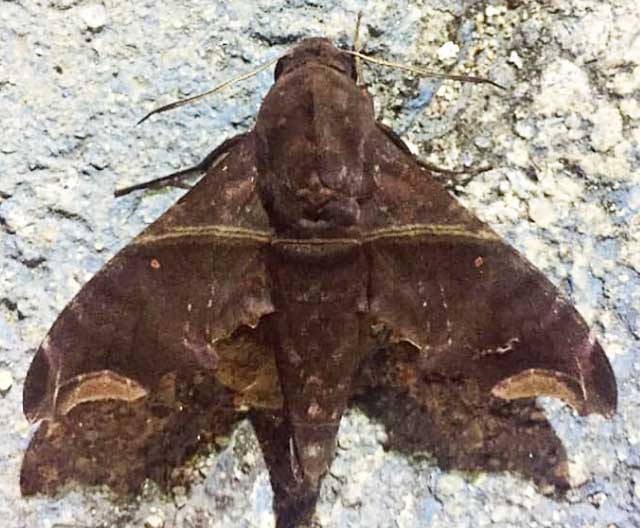
Enyo ocypete male, Aruana, Goias, Brazil,
May 1, 2020, courtesy of Kennedy Road.
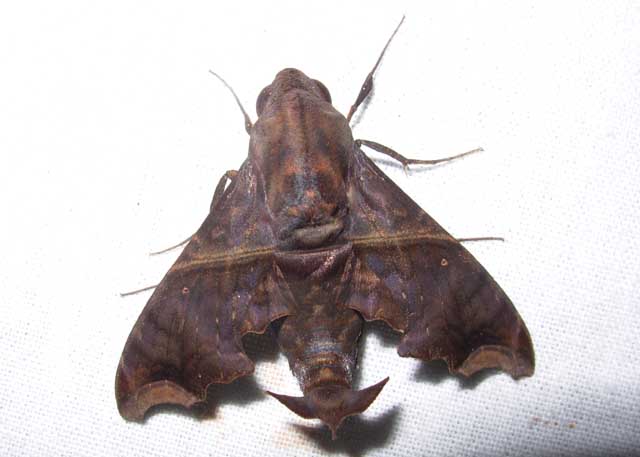
Enyo ocypete, Yacutinga Private Reserve, Misiones Province,
(near border between Argentina and Brazil), February
courtesy/copyright of Ezequiel Osvaldo Núñez Bustos.
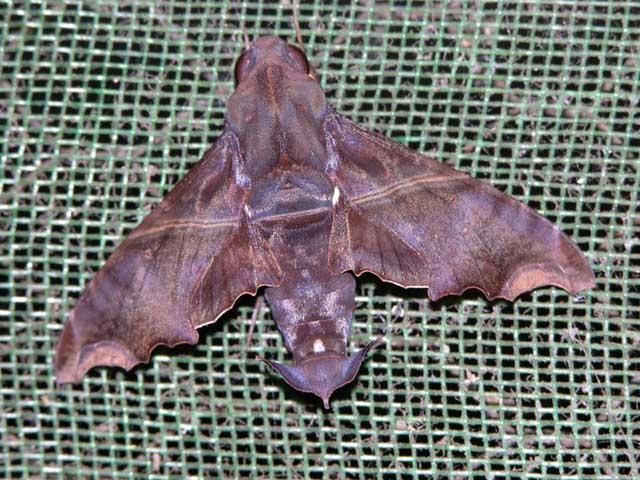
The "horn" is very long in early instars and head is relatively large. As the larva matures, the body develops rapidly, leaving the head relatively small and the "horn" relatively short. Mature larvae show considerable variation with one morph being quite pink.


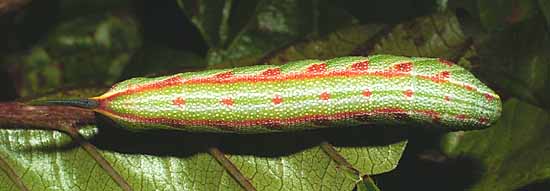
The pupa is dark and smooth with a sharp cremaster. Moths emerge in as few as fourteen days from pupation date. | 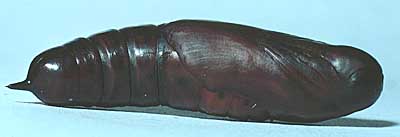
|
Larvae may be parasitized by Belvosia sp. of the Tachinidae family and by Euplectrus floryae of the Eulophidae family.
Use your browser "Back" button to return to the previous page.
Return to Sphingidae Index
Return to Dilophonotini Tribe
Use your browser "Back" button to return to the previous page.
This page is brought to you by Bill Oehlke and the WLSS. Pages are on space rented from Bizland. If you would like to become a "Patron of the Sphingidae Site", contact Bill.
Please send sightings/images to Bill. I will do my best to respond to requests for identification help.
Enjoy one of nature's wonderments: Live Saturniidae (Giant Silkmoth) cocoons.
 Show appreciation for this site by clicking on flashing butterfly to the left. The link will take you to a page with links to many insect sites. |